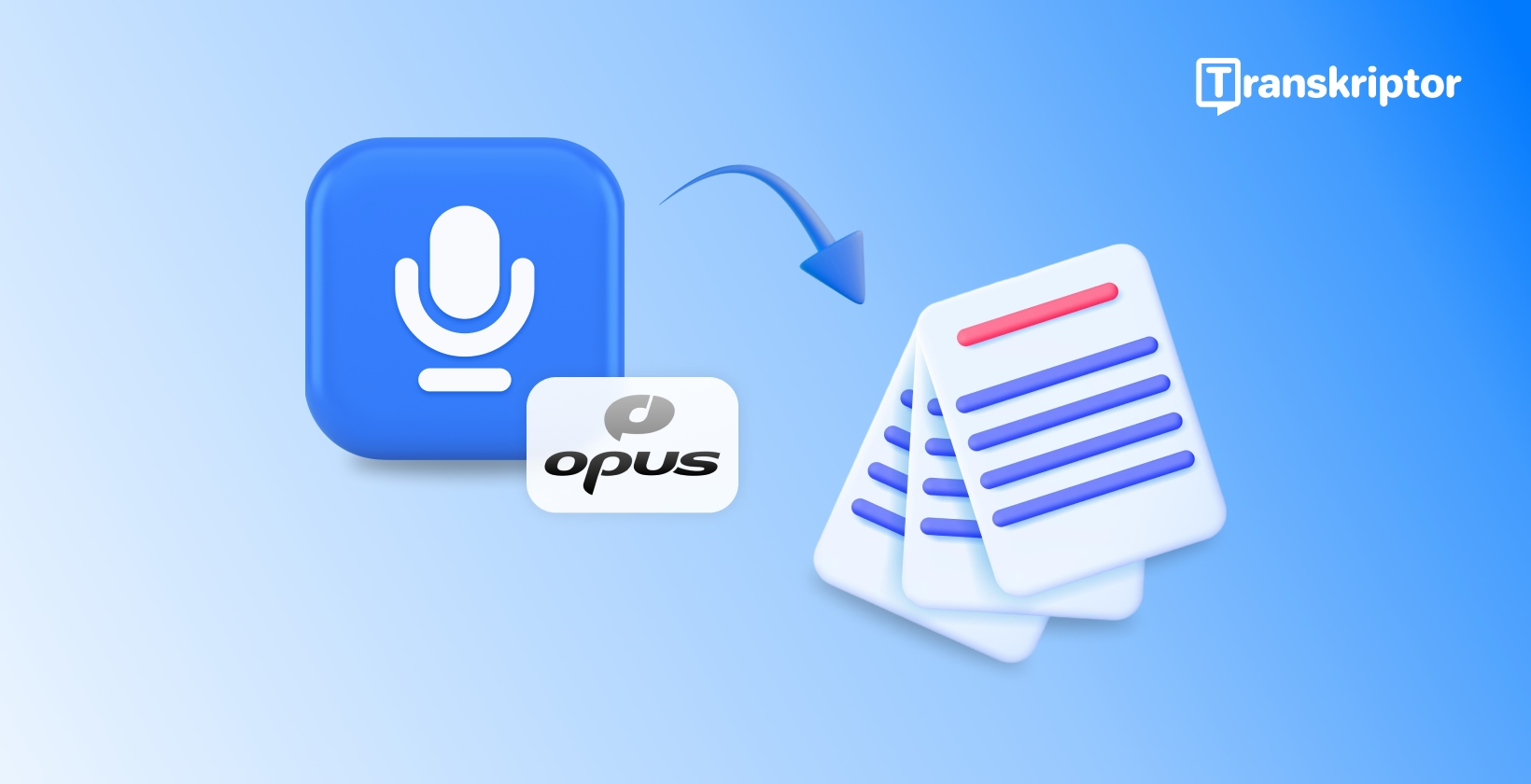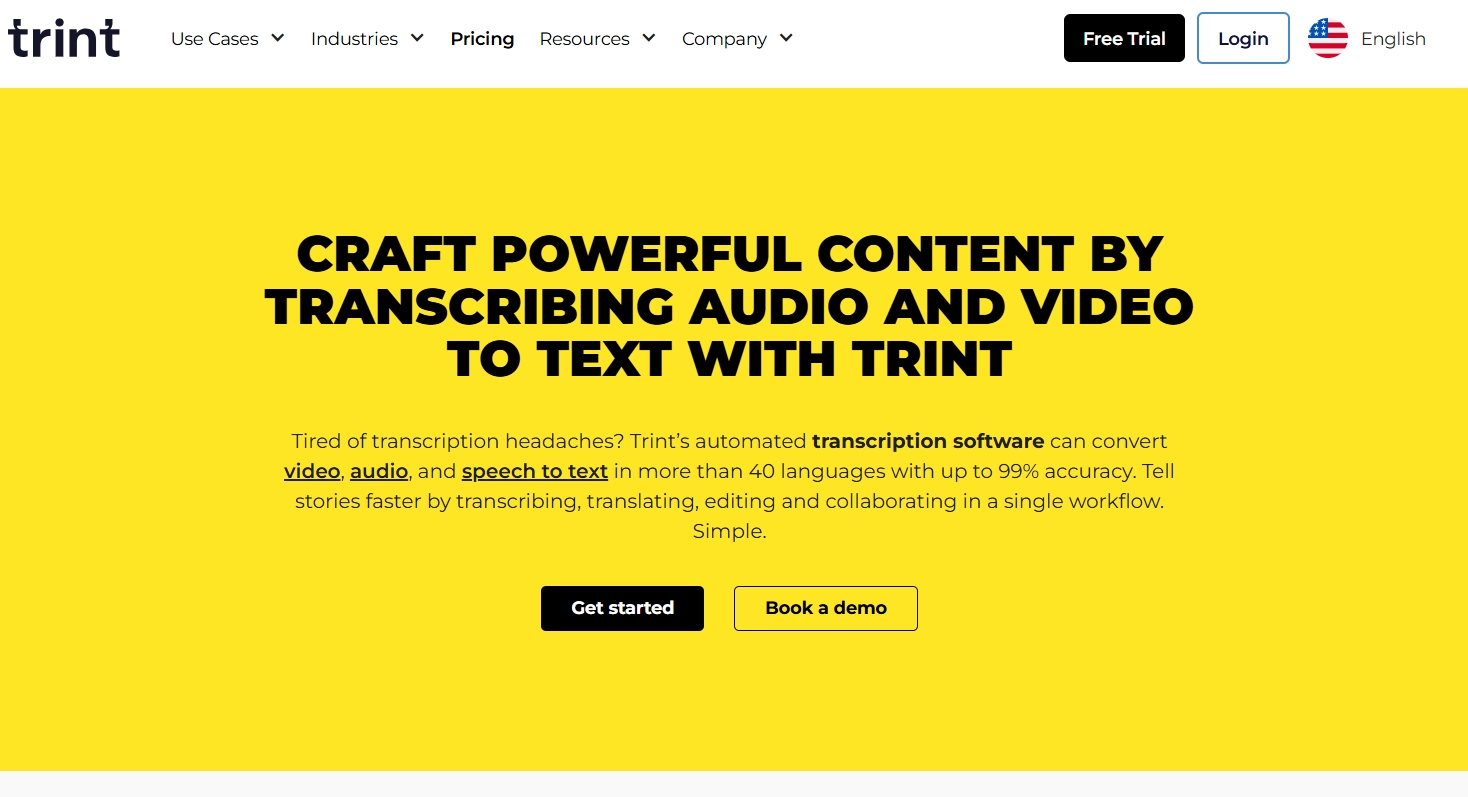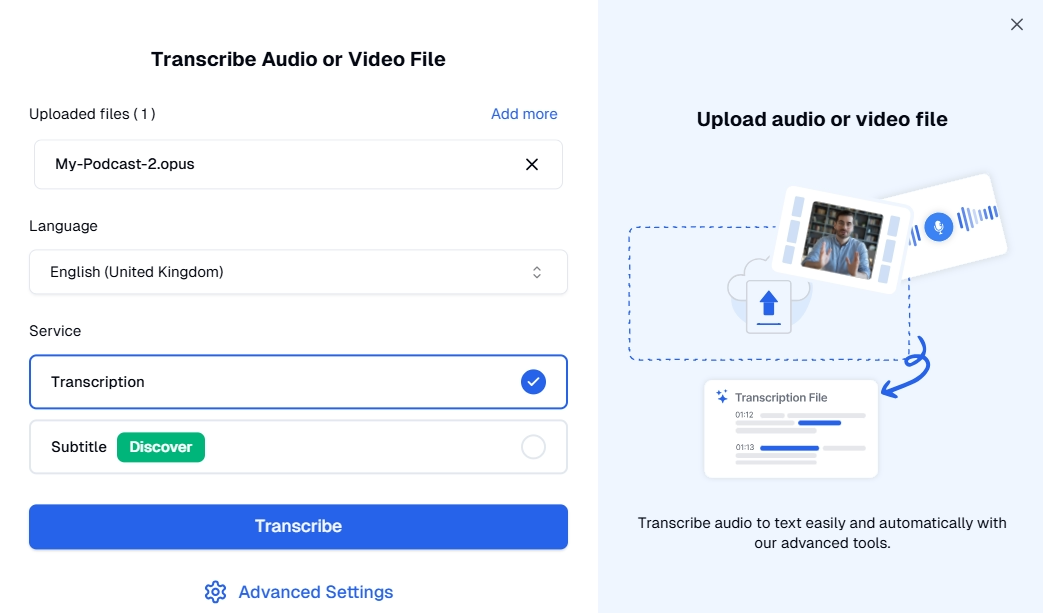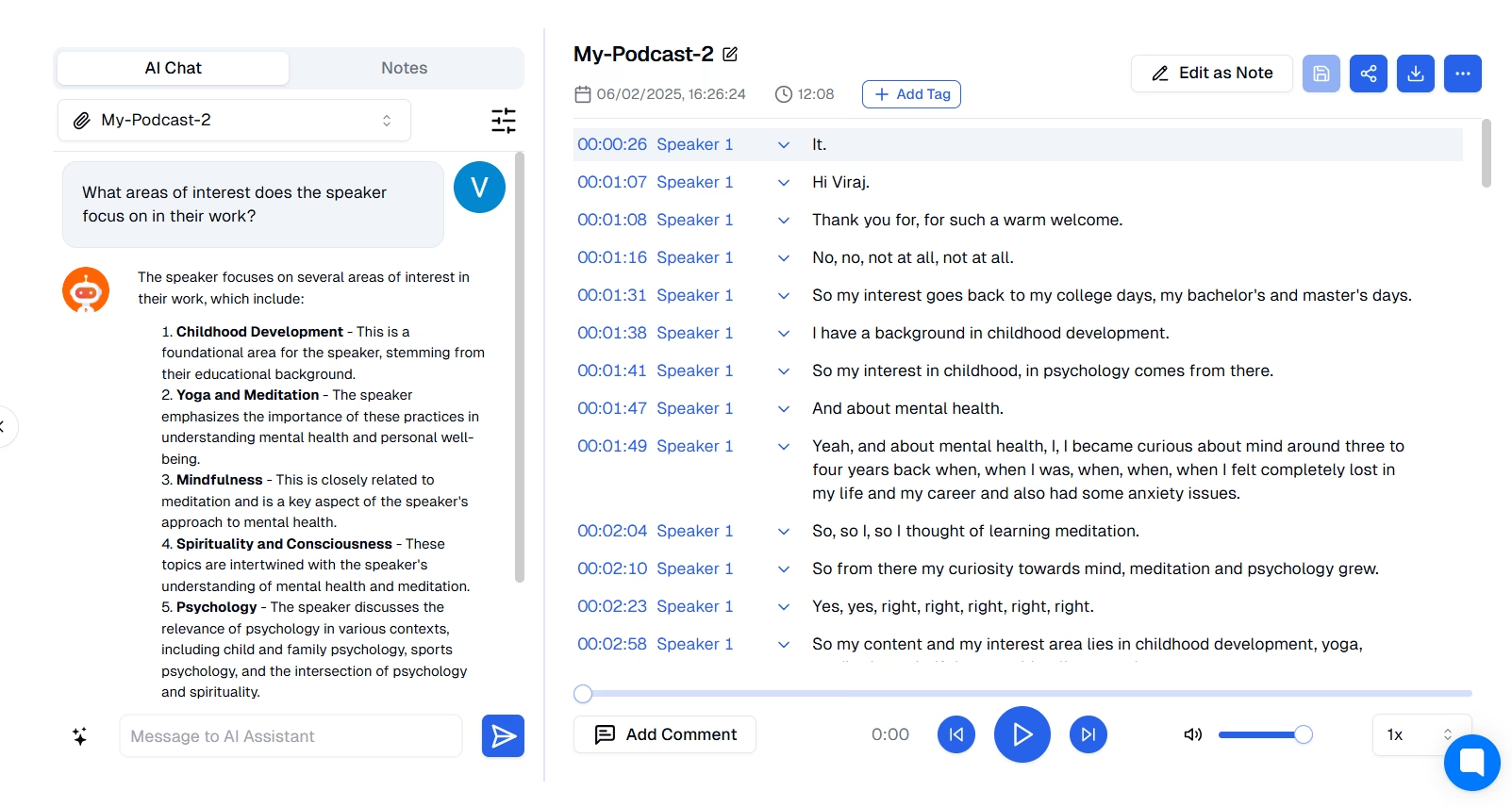
Opus Audio Converter: How to Transcribe Audio to Text
Table of Contents
- Understanding Opus Audio Format and Transcription
- Methods for Converting Opus Audio to Text
- Top Professional Transcription Solution
- Step-by-Step Guide to Transcribing Opus Audio
- Advanced Features for Professional Transcription
- Tips for Maximizing Transcription Accuracy
- Future of Audio Transcription Technology
- Conclusion
Transcribe, Translate & Summarize in Seconds
Table of Contents
- Understanding Opus Audio Format and Transcription
- Methods for Converting Opus Audio to Text
- Top Professional Transcription Solution
- Step-by-Step Guide to Transcribing Opus Audio
- Advanced Features for Professional Transcription
- Tips for Maximizing Transcription Accuracy
- Future of Audio Transcription Technology
- Conclusion
Transcribe, Translate & Summarize in Seconds
Opus is one of the most popular audio formats available. However, when converting it into text, you might encounter several challenges. It includes heavy accents, technical jargon, and the involvement of multiple speakers. A high-quality Opus audio converter can deal with these.
You can use it to transcribe meetings, lectures, interviews, and more. However, multiple aspects must be considered when selecting an audio converter, such as accuracy, integrations, and security. This comprehensive guide details these and helps you generate high-quality transcripts from Opus files.
Understanding Opus Audio Format and Transcription
Opus is one of the most popular audio formats, primarily used for internet streaming. In fact, Meta says it uses Opus to communicate in real-time with more than a billion users worldwide.
What is Opus Audio Format?
Opus is an open, royalty-free, versatile audio codec format that allows high-quality compression. Whether you are a podcaster or musician who requires real-time communication, Opus should serve you well while maintaining low bit rates. The best part about Opus is that it does not take up much space.
Benefits of Converting Opus Audio to Text
The Opus audio-to-text conversion might not seem simple, but it can impact your marketing and business operations. Whether increasing audience, better SEO, or content repurpose, it can impact in many ways.
- Increase Audience : People watch your videos in multiple scenarios, and some might not turn on the volume. Many of your audiences might also have hearing disabilities. Opus file transcription allows you to add subtitles that viewers can read alongside.
- Break Language Barriers : You can convert your transcriptions into languages other than English. This way, your content will be watchable by audiences in different countries.
- Repurpose Content : You can use the text format of Opus and turn it into an ad copy or blog article.
- Better SEO : Adding transcripts in Opus files helps search engines index and rank higher on search results.
Key Obstacles in Opus Audio-to-Text Conversion
Generating an Opus file transcription is not as easy as it seems. You might encounter one or more of the following challenges:
- Audio Quality : Low-quality audio with noise or distortion can impact the transcription accuracy.
- Speaker Variations : Different dialects, accents, and speech patterns can cause misinterpretations. The software also finds it challenging when multiple speakers are involved.
- Technical Jargon : The transcription tool might struggle to interpret specialized vocabulary.

Methods for Converting Opus Audio to Text
Typically, there are many ways to convert opus recordings to text. For example, you can use automated or manual transcription software. With Opus files, automated tools are the best idea.
Manual Transcription vs. Automated Solutions
With AI taking over, manual transcription is becoming less popular. However, it offers certain advantages, especially in terms of accuracy. Manual transcription shines when transcribing legal, academic, or medical documents but is time-consuming.
Since it requires human intervention, privacy concerns are always present. On the other hand, automated tools offer quick transcriptions while offering high-security levels and many modern tools claim to generate accurate transcripts.
Key Features to Look for in Transcription Tools
Although automated tools save time, selecting one can be a cumbersome job with so many options available. You must look for accuracy, processing time, integrations, and intuitive interface.
- Accuracy : Accuracy is probably the most crucial aspect to consider in your decision-making process. Look for highly accurate software that uses AI and advanced algorithms to improve its quality over time.
- Processing Time : Depending on transcription volume and deadline, select software that lives up to it without sacrificing accuracy.
- Integrations : The Opus audio transcription software must integrate with other apps to streamline your workflow.
- Ease of Use : Select software with an intuitive interface and not that requires watching hours of tutorial videos.
- Security : Review the security parameters of the transcription tool and ensure they are robust.
Top Professional Transcription Solution
Grand View Research forecasts the US transcription market to reach $41.39 billion by 2030. Such an increasing demand led to the incidence of many automated tools; however, the following are the best:
- Transkriptor : The Opus converter is an AI transcription tool with an intuitive interface, multilingual support, and other advanced features.
- Descript : It is a video editing and transcription tool that supports Opus and other popular audio file formats.
- Trint : AI software supports 50+ languages and lets you add custom texts for easy understanding.
- Sonix : Sonix provides a smooth and efficient transcription experience with multilingual support and editing tools.

1. Transkriptor
With excellent accuracy and affordable price, Transkriptor is a popular choice for transcribing Opus files. The tool can transcribe your files in 100+ languages, including English, German, Spanish, Hebrew, and more. It offers an intuitive interface that makes it suitable for beginners as well. Its smart speaker detection feature is accurate. In an audio with 3-4 speakers, the tool could segregate each of them precisely. Besides, its search and edit functionality lets you refine your text and download it in your desired format.
Key Features:
- Multiple File Format : Aside from Opus, Transkriptor supports the most popular audio and video file formats.
- AI Chat : Interact with AI for personalized training, support, and information retrieval. You can also ask it to generate transcript summaries.
- Notes : A dedicated section to jot down the ideas, tasks, and reminders.
- Zapier Integration : Automate workflows by integrating with over 1000 apps using Zapier.
- Storage : Transkriptor integrates with Google Drive and Dropbox to provide secure storage space for your transcripts.

2. Descript
Descript is a video editing tool that functions as an Opus format transcriber. If the audio is not crisp enough, you can use Studio Sound to make it sound professional. This allows for an accurate transcription. The platform is SOC 2 Type II compliant, so all your data is encrypted and safe. The platform is only available on Windows and Mac, and there is no dedicated mobile application. Also, the learning curve is steep, making it unsuitable for beginners.

3. Trint
Trint is an AI-based software that lets you transcribe your Opus files in 50+ languages. It also supports multiple formats, including WAV, MP3, AAC, M4A, and others. Besides, its output is reasonably accurate with clear audio and lets you add up to 100 custom texts. However, accuracy drops significantly when more than two speakers are involved.

4. Sonix
Sonix is another popular Opus voice-to-text converter that uses AI to perform the operations. It works on your browser, so there is no need to download an app. Once you generate a transcript, you can use its editing tools to correct errors. You can also translate it into 53+ available languages within the workflow. However, its standard transcription cost per audio is around $1.5 per minute. The rates might add up to a considerable sum when transcribing a lengthy audio file.
Step-by-Step Guide to Transcribing Opus Audio
To transcribe your Opus files, you must use specialized software like Transkriptor. Its simple interface makes way for a seamless transcription.
Step 1 : Open the Transkriptor website and click “ Login/Register ” or “ Try for Free .” Log in using your email address or existing Gmail account.

Step 2 : Click on Upload Audio or Video file > Browse files in the popup and select your Opus audio file. Then, select the language and service and click on “ Transcribe .”

Step 3 : The tool will process the Opus files and convert them into text within minutes. You can edit, share, or download directly from there. Also, you can ask its AI chat questions regarding the transcript.
Advanced Features for Professional Transcription
Other than the basic features like accuracy, processing time, and integrations, you must look for advanced features. It should include support for multiple languages, collaboration features, and more.
- AI-Powered Tools and Automation : The machine learning algorithm of the tool must generate accurate texts, irrespective of the audio quality.
- Multi-Language Support : The tool must be able to generate accurate transcripts in multiple languages.
- Collaboration and Sharing Options : The ability to share the transcript with teams and make edits ensures convenience.
AI-Powered Tools and Automation
The Opus audio file converter must employ advanced ML and deep learning algorithms to detect accents and technical jargon. It can also analyze speech patterns and identify individual speakers, even when conversations overlap. These algorithms continuously improve as more data is fed into them.
Multi-Language Support
Some tools have multilingual support, which helps break down language barriers and create content in multiple languages. These tools can capture the nuances of spoken dialogues and transcribe them in different languages while maintaining accuracy.
Collaboration and Sharing Options
Many transcription software offers collaboration features like sharing transcript access, making edits, and commenting capabilities. This lets team members stay on the same page and updated with the project's progress. Transkriptor is a great platform that enables you to share files directly from the platform.
Tips for Maximizing Transcription Accuracy
A study by Forbes reveals that the accuracy of AI systems averages around 12%. To improve the number, you must keep a few aspects in mind and make the necessary edits before downloading.
Pre-Transcription Audio Enhancement
Audio quality is the single most crucial factor that affects transcription accuracy. Poor audio quality could result in errors and affect turnaround time. To avoid that, record in a quiet environment without disruptions or background noise. You must use a high-quality microphone and speak steadily to generate a clear and crisp audio quality.
Post-Transcription Editing Techniques
Although AI claims to be accurate, human intervention is essential. So, you must look for grammatical errors, fillers, and the context.
- Clean-up Fillers : Many Opus audio transcript generators offer search functionality. Use it to find the filler words like “uh,” “um,” and others to improve readability.
- Fix Grammatical Issues : Check for any grammatical and spelling errors like punctuation and subject-verb agreement, and fix them.
- Speaker Attribution : These tools might struggle in audio where multiple speakers are involved.
- Contextual Adjustments : If you are regenerating a transcript in other languages, make changes in the wording to improve clarity.
Quality Assurance Best Practices
Quality assurance is important to achieve Opus speech-to-text accuracy. For that, it is crucial to invest in high-quality tools, train the AI, and review the output.
- Use High-Quality Tools : Select reliable transcription software and invest in a high-quality microphone to minimize the external sound.
- Understanding Industry Terminology : Invest time in feeding data to software to become accustomed to industry terminology and avoid misinterpreting it.
- Reviews : Conduct at least 2-3 rounds of proofreading to catch any errors or inconsistencies.
- Regular Sampling : Collect the transcription samples regularly to notice the accuracy levels.
Future of Audio Transcription Technology
As you move forward, the demand for automated transcription software will rise. So, brace yourself for emerging trends and exciting new projects that will make the most of transcription!
Emerging Trends
The key transcription trend this year is the emergence of powerful AI-based transcription software. The tools will have a robust ML and NLP algorithm to produce near-perfect transcriptions. Also, you can expect stricter accessibility regulations, accent and multiple language recognition improvements, and more.
What to Expect in Coming Years
The US Bureau of Labor Statistics predicts a 9% increase in employment in medical records by 2033. AI tools come as an affordable and accessible solution to generate automatic opus transcription without specialized training. Irrespective of the industry, AI transcriptions benefit in terms of cost and time. So, you can expect an increased use of AI tools for transcription.
Conclusion
Opus is a popular audio format for lectures, meetings, and voiceovers. It ensures a high-quality output and takes up less space. Transcribing it offers the benefits of accessibility, searchability, and comprehension. However, it requires an Opus audio converter that provides a high-accuracy transcript. An AI transcription tool like Transkriptor is accurate and streamlines your transcription process. The tool also lets you edit and share the transcript once it is generated. So, try it today for free!
Frequently Asked Questions
An Opus is an open-source and high-quality audio file format developed for internet streaming. The best part is that it takes less space and supports variable bitrates.
Compared to the most popular MP3 format, Opus offers much better audio quality at similar bitrates. It also has better compression efficiency, making the files much smaller.
You can use tools like Transkriptor to convert Opus files to text. It transcribes audio files with a higher accuracy in 100+ languages as well.
Transkriptor stands in the market with a quick turnaround time, better efficiency, and more format support. It also offers editing tools to create a precise transcript.

